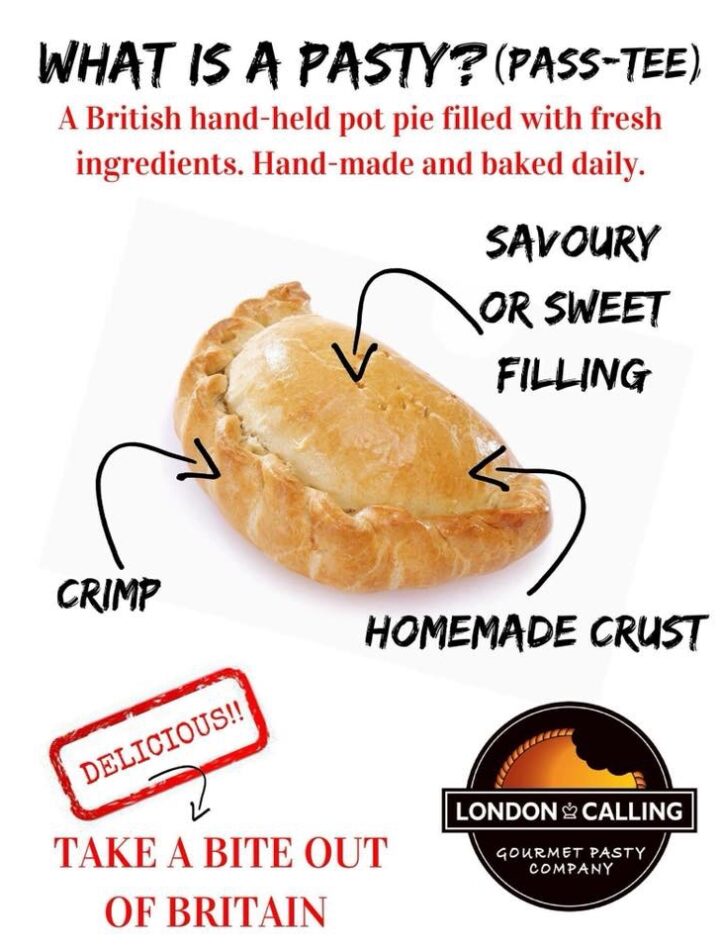When we started London Calling in 2013, we knew we were in for some explanations as to what we were selling, how to pronounce it and several times we had to convince guests we had not forgotten the “r” in pastry. We discussed changing the name to something Americans could more easily understand–like hand pie– but decided pasties are so steeped in tradition and history we felt we didn’t dare.
So, what the heck is a pasty? Pasties are a hand held pot pie filled with steak, potatoes, onion, and rutabaga, and simply seasoned with salt and pepper and butter. The crust is traditionally a short crust (a pie crust) made from approximately 50% fat (butter, lard, shortening, margarine and usually a combination of two), 50% “strong” flour (akin to our bread flour, the strong referring to the gluten content), salt and water. It is a sturdy pie crust that maintains a nice flakiness. The crust is sealed around the fillings with a distinguishing rope-like crimp. When you mix this rich crust with the juices of the meat, the combination of onion and potatoes and the sweet, aromatic nature of the rutabaga you get a simple but deeply satisfying meal.
Pasties have origins in Cornwall, England (coastal southwest England). These meat pies have been a part of the Cornish tradition since the 1700 and 1800’s and are strongly attributed to the mining community there. Though only remains of the mines are left, the Cornish pasty lives on and provides tourists hearty nourishment on holiday.
Cornish pasties are geographically protected and a source of great pride in Cornwall. To be geographically protected means that they can only be referred to as Cornish pasties if they are made in Cornwall with Cornish ingredients in the right percentages and include the signature side closure called a “crimp” (18- 20 twists on a D shaped pasty is the goal and not on the top like the neighboring folks in Devon). Though Cornwall claims the pasty that we know today, the pasty actually dates back 800 years to the 13th century (thevalleycornwall.co.uk).
Today, the pasty has made its way into all of Great Britain and appears anywhere that the British colonized or emigrated. In fact, there is a strong pasty tradition in the Upper Peninsula of Michigan. I have seen them being sold in a handful of states outside of Michigan and pasties have even made it to London Calling Pasty Company in Springfield, Missouri, USA! If you have never tried a traditional pasty I highly recommend that you do so. You won’t forget the comforting flavors or warm aromas. Here is the traditional Cornish style pasty recipe for you to make at home. Check out this quick video for a visual But if you don’t have the time, remember you can buy them hot or take and bake at London Calling Pasty Company.
The Traditional Cornish-Style Pasty (Oggie)
Equipment
- 1 Cookie Sheet To Cook the Pasties On
- 1 Medium Bowl To Mix the Pasty Dough
- 1 Rolling Pin To roll the dough into rounds. Fondant Rollers and great for pasties
- 1 Whisk or Fork To whisk the egg wash
- 1 Large Sieve To sift the flour
- 1 Pastry Brush To brush the egg wash onto the tops of the pasties for a golden brown
- 1 9" cake pan To use as a guide for rolling out the dough
- 1 Fork To use to seal the pasty if you don't crimp the edge
- 6 Small Bowls To make the egg wash, hold the ice water and for the ingredient assembly line
- 1 Set Measuring Cups
- 1 Set Measuring Spoons
- Plastic Wrap To wrap the dough and chill
- 1 Butter Knife
Ingredients
Shortcrust
- 3 1/2 Cups Bread Flour, Sifted. Plus 1/4 cup extra for rolling out dough. All purpose flour will also work.
- 1 Teaspoon Salt
- 8 Tablespoons Butter, chilled, cut into small chunks (1/2 cup or 1 Stick butter)
- 1/2 Cup leaf lard or shortening, cut into small chunks
- 1 Cup Water (prepare but only used what is needed). Add ice to the water to chill
Filling
- 3/4 Pound Raw beef skirt or chuck steak, cut into small pieces Leaner meats can be used but will lack the flavor and juices needed for a proper pasty
- 1/2 Pound Raw Yukon Gold potato, peeled and diced small These can be diced ahead of time and covered with water to prevent browning.
- 3/4 Pound Raw Rutabaga, Peeled and Diced small (11 oz) Raw
- 1 Small Raw White or Yellow Onion, finely diced (5 oz) Raw
- 3 Tablespoons Butter, cut into 5 equal pieces
- Salt & Pepper
Egg Wash
- 1 Egg, whole
- 2 Tablespoons Milk You can also use water if you don't have milk
Instructions
Shortcrust
- Place the large sieve over the medium bowl, measure 3 1/2 cups flour with a spoon into the measuring cup. Level off each measure using the backside of a butter knife. Pour into the sieve. Add the 1 tsp salt. Gently tap the side of the sieve over the bowl until the flour and salt are sifted. Add the 8 Tablespoons of butter in small chunks and the 1/2 cup of leaf lard or shortening. Use your fingers or a pastry cutter to work the fat into the flour. With your fingers rub the butter/shortening between the thumb and the rest of the fingers. It should eventually look like sand. It's okay to have some pieces a little bigger than sand. Sprinkle the iced water 4 Tablespoons at a time over the flour/butter mixture. You will use roughly 16 Tablespoons but humidity can make a big difference so judge by sight and feel. Using your hands, pull from the bottom and lightly toss until the dough starts to clump into larger pieces. Gently press with your hands until the dough just comes together. It should not be sticky, nor should it be crumbly. Press the dough flat, fold it over, turn it, press it flat, fold it over, turn it and do this 1 more time. (This is a light knead). Make the dough ball into 5 equally sized smaller balls. Flatten with the palm of your hand into a puck shape and wrap the dough pucks individually in plastic wrap. Refrigerate for at least 1 hour or overnight. This dough can be held for up to 3 days. Have a glass of wine.
Egg Wash
- Whisk the egg and milk together in a small bowl until fully combined.
Filling and Crimping
- After the dough has been in the refrigerator for about 45 minutes, preheat the oven to 350 degrees Fahrenheit.
- Dice the rutabaga, potato, onion and steak into a small dice. You can chip or slice the vegetables if you prefer. I prefer the dice as I think it allows more flavor.
- Pull the dough pucks from the refrigerator and use the rolling pin to roll out a round circle about 1/8th inch thick. If you stack the dough rounds, add a little flour between each one or use parchment paper to separate. Do this with each puck. You want about a 9" diameter. You can use a 9" cake pan as a guide.
- Clear your counter and set up an assembly line of dough rounds, diced beef, vegetables, butter, salt and pepper and egg wash. Lay out a dough round. With your pastry brush, brush egg wash onto the outer edge of the pasty. Layer all the veggies and the beef in this order for a nice balance: Onion Rutabaga, Steak, Potato, Rutabaga. Top with the 1/5th of the butter (1 butter piece for each pasty). You should end up with roughly 1 cup of veggies and meat per pasty. Lightly salt and pepper. (Use a couple of pinches of salt and a pinch of pepper as a guide)
- Fold the round in half over the veggies and meat, pushing the veggies and meat back into the pasty if they fall out of the sides. Using your hands in a half moon shape, shape and seal the ingredients inside the pasty so that it looks like a mounded half circle or rising sun shape. Where the sides of the dough circle meet, seal the edges (pick out any veggies or meat that get trapped) with the rolling pin or your fingers and then crimp that edge or you can decorate the edge with a fork for an easier seal. Use the butter knife or a fork to make a vent hole in the top of your pasties so that steam can escape during the cooking process.
- Place each pasty onto the cookie sheet leaving room for some expansion in size and brush with the egg wash. This creates a golden brown pasty. Wherever you paint, you will have a beautiful brown. Whereever you miss, you will have a pasty pasty!
- Bake the pasties for about 55 minutes. Watch for the bubbling from the vent hole. At this time the insides will be soft and tender but go for a nice golden brown on the outside before you pull it from the oven.

